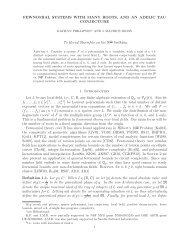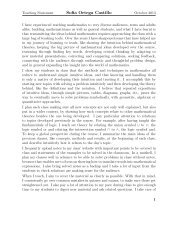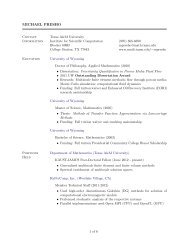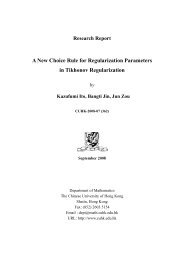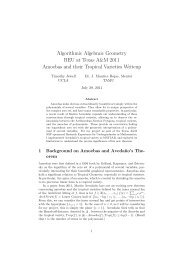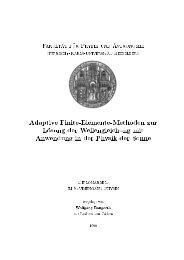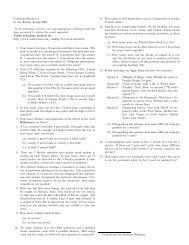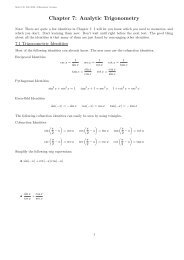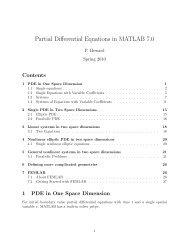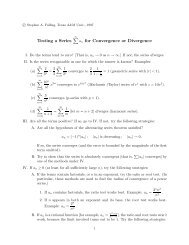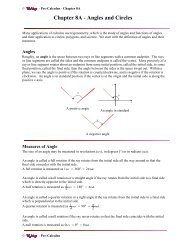Tensors: Geometry and Applications J.M. Landsberg - Texas A&M ...
Tensors: Geometry and Applications J.M. Landsberg - Texas A&M ...
Tensors: Geometry and Applications J.M. Landsberg - Texas A&M ...
You also want an ePaper? Increase the reach of your titles
YUMPU automatically turns print PDFs into web optimized ePapers that Google loves.
14 1. Introduction<br />
the rank of this matrix will be r. (In practice, the matrix will be “close” to a<br />
matrix of rank r.) The matrix κ2(x) is called a covariance matrix. One can<br />
define higher order cumulants to obtain further measurements of statistical<br />
independence. For example, consider<br />
(1.3.1) κ ijk = m ijk − (m i m jk + m j m ik + m k m ij ) + 2m i m j m k .<br />
We may form a third order symmetric tensor from these quantities, <strong>and</strong><br />
similarly for higher orders.<br />
Cumulants of a set of r<strong>and</strong>om variables (i.e. functions on a space with<br />
a probability measure) give an indication of their mutual statistical dependence,<br />
<strong>and</strong> higher-order cumulants of a single r<strong>and</strong>om variable are some<br />
measure of its non-Gaussianity.<br />
Definition 1.3.2.2. In probability, two events A,B are independent if<br />
Pr(A ∧ B) = Pr(A)Pr(B), where Pr(A) denotes the probability of the<br />
event A. If x is a r<strong>and</strong>om variable, one can compute Pr(x ≤ a). Two r<strong>and</strong>om<br />
variables x,y are statistically independent if Pr({x ≤ a} ∧ {y ≤ b}) =<br />
Pr({x ≤ a})Pr({y ≤ b}) for all a,b ∈ R+. The statistical independence of<br />
r<strong>and</strong>om variables x 1 ,...,x m is defined similarly.<br />
An important property of cumulants, explained in §12.1, is:<br />
If the x i are determined by r statistically independent quantities, then<br />
RS(κp(x)) ≤ r (with equality generally holding) for all p ≥ 2.<br />
We will apply this observation in the next subsection.<br />
1.3.3. Blind source separation. A typical application of blind source<br />
separation (BSS) is as follows: Big Brother would like to determine the<br />
location of pirate radio transmissions in Happyville. To accomplish this,<br />
antennae are set up at several locations to receive the radio signals. How<br />
can one determine the location of the sources from the signals received at<br />
the antennae?<br />
Let yj (t) denote the measurements at the antennae at time t. Assume<br />
there is a relation of the form<br />
⎛<br />
y<br />
⎜<br />
(1.3.2) ⎝<br />
1 (t)<br />
.<br />
ym ⎞ ⎛<br />
a<br />
⎟ ⎜<br />
⎠ = ⎝<br />
(t)<br />
1 ⎞<br />
1<br />
⎟<br />
. ⎠ x 1 ⎛<br />
a<br />
⎜<br />
(t) + · · · + ⎝<br />
1 ⎞<br />
r<br />
⎟<br />
. ⎠ x r ⎛<br />
v<br />
⎜<br />
(t) + ⎝<br />
1 (t)<br />
.<br />
vm ⎞<br />
⎟<br />
⎠<br />
(t)<br />
a m 1<br />
which we write in vector notation as<br />
(1.3.3) y = Ax + v.<br />
Here A is a fixed m × r matrix, v = v(t) ∈ R m is a vector valued function<br />
representing the noise, <strong>and</strong> x(t) = (x 1 (t),... ,x r (t)) T represents the statistically<br />
independent functions of t that correspond to the locations of the<br />
a m r



